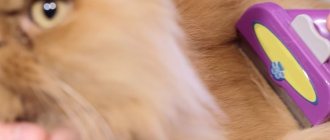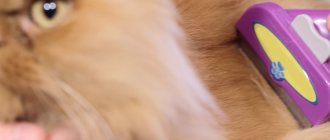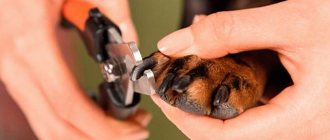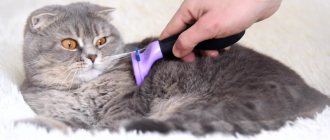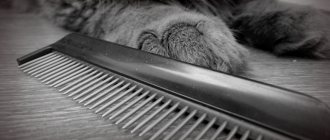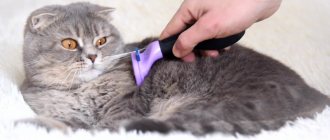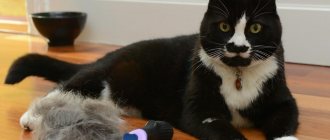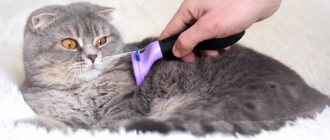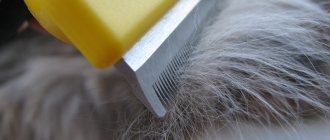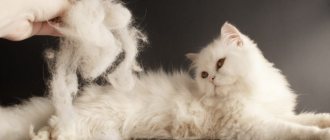What will you learn from the article?
- How to choose a furminator for a cat
- How to use a furminator?
- How often should you brush your fur with a furminator?
- My review or benefits of use:
- Who should not use the furminator? How much does a furminator cost?
There is a known problem - an incredible amount of wool on clothes, furniture, and woolen tumbleweeds rolling around throughout the apartment. Previously, combs or brushes were used to care for the fur of cats, they have been replaced by combs and furminators for cats, designed for the size of the breed and the peculiarity of the coat. All the details are below.
Furminators are firmly established in the everyday life of cat lovers in many countries around the world and have only positive reviews. Here, in the CIS countries, only a certain part of caring owners know what a furminator is and have already been able to appreciate all its advantages.
A cat furminator is a tool that greatly facilitates the process of combing hair. This is a comb that works on the principle of a trimmer, resembling a mini rake with fine teeth. The Furminator was invented by groomers from the USA who know first-hand the problems of caring for animal hair.
Furminator for dogs - what is it and how does it work
The Furminator is an improved comb for removing undercoat on dogs, cats, rabbits, and horses. The tool was invented by American groomers Angie and David Porter. In 2000, they patented the FURminator deShedding trademark and launched production in China.
Now other companies are creating furminator combs. The FURminator brand name has evolved into the name of a tool for manually removing loose hair from pets.
Externally, the furminator resembles a razor, but instead of blades, a comb is attached to the handle. The teeth along their length are covered with excisions invisible to the eye, and are rounded at the tips. The distance between them is strictly adjusted so that the guard hair can pass freely.
When combing, the comb catches dead hair and lifts it to the surface without cutting or tugging. “Living” guard and integumentary hair slips between the teeth and remains intact.
When not to use the tool
Despite its advantages, the accessory also has a number of contraindications. Restrictions on use are imposed if the coat type is unsuitable and in the presence of certain diseases or injuries.
Breeds that should not be scratched with a furminator
It is prohibited to comb animals with long, thin and silky hair, such as lapdogs, Yorkies, Shih Tzus and Afghan hounds. Blades of such great length are simply not available.
Also, you should not use the tool if the dog has curly and rough fur (poodles, Airedales, Komondors). When combing, it catches and smoothes the hairs, removing the curls inherent in the breed.
The main task of the product is to remove undercoat. For this reason, it is simply pointless to use it for combing smooth-haired (dachshunds, bulldogs, Dobermans) and completely hairless (Chinese Crested, Peruvian dogs) breeds.
Temporary contraindications
Temporary contraindications include multiple tangles, any damage to the skin and dermatological diseases. If your pet is injured or suffers from eczema, postpone brushing until it recovers. Otherwise, you will only hurt him and make the existing problem worse.
Advantages and disadvantages
With a regular comb it is difficult to reach the undercoat and remove it completely; the slicker scratches the skin and tears the living hair. The Furminator clearly wins over traditional instruments:
- Removes lifeless fur faster.
- Captures the undercoat deeper and completely removes already fallen hair.
- Reduces seasonal molting time by 2 times.
- Does not cause pain, does not leave scratches.
- Massages the skin.
- It does not tear the guard hair, and after treatment the coat looks healthy and neat.
- Evenly distributes fatty lubricant, which moisturizes the skin and forms a protective film on the surface.
- Prevents tangles from forming.
- During shedding, the house looks cleaner and tidier.
Furminators have only 2 drawbacks. They cost more than regular combs and brushes and are not suitable for all coat types. The price of furminators is from 900 to 3000 rubles.
Feedback from cat owners about the furminator comb
Based on numerous responses from people who bought a tool for their pets, we can safely classify the Furminator as a useful cat fur care item. The following are some reviews from grateful owners:
Review #1:
“My friend and I have been running a Scottish cattery for 5 years. Therefore, I can safely say that no slicker will remove the undercoat as well as a furminator. We comb our pets with American FURminator combs; there are no balls of wool anywhere, although the seals’ coats are very thick and they shed a lot...”
Review No. 2:
“Previously, when Barsik was molting, fur was everywhere. Particularly annoying were the red hairs that had settled on dark clothes. And it was unpleasant to see the cat’s hair on the kitchen table. The furminator helped me a lot, although I didn’t have high hopes for it. I was even surprised when I combed out a whole mountain of wool for the first time using this device...”
Review #3:
“I was forced to buy a furminator by misfortune: the cat swallowed hair to such an extent that intestinal obstruction developed. My cat, named Molly, by the way, loves it when I brush her: she purrs and caresses her. The hairs separate quickly; it takes me no more than 15 minutes to do everything…”
How to choose a Furminator for a dog
Before purchasing, consider the details of the tool:
- The size of the teeth, the distance between them. The Furminator will comb out the undercoat well if the length and frequency of the teeth correspond to the animal’s coat. Too many short teeth will not reach the undercoat of long-haired, fluffy dogs. Rare long ones will not capture dead hair in short-haired animals.
- Quality of the working surface. In good quality instruments, the comb is made of durable stainless alloy. Upon examination, the teeth are even, shiny, smooth, without scratches, gaps or irregularities. To check, run the comb over your head. A good comb allows the hair to slide freely, leaving only traces of dust on the teeth.
- Ridge width. Estimate the size of the dog, weigh the pet. Mentally imagine which comb will remove the undercoat faster and more thoroughly. A miniature comb 3.5 cm wide will take more than an hour to treat a large dog. Wide combs 10–12 cm are inconvenient for combing small animals. For giant and large dogs, it is better to use two combs: a wide one for processing the body, a medium one for bends, paws, and head.
- Ergonomic handle. The comb with a textured rubber insert and a convex end on the handle does not slip out of the palm. For the rest, look at how you feel: how comfortable the instrument fits in your palm. The hand will quickly get tired if the length or width is not suitable, the tool is too heavy or constantly pops out.
- Fur reset button. This addition speeds up combing, but weakens the structure. Simple models are more durable, and hair is not difficult to remove with your hands.
- Additional functions. Manufacturers are constantly improving tools. They produce models with removable combs and sets of attachments of different widths, lengths and frequencies of teeth. Such tools are convenient to use when there are several animals of different sizes in the house. However, classic monolithic combs with bolted combs work longer.
New models have a vibration massage system built into them and are battery-powered. The animal may not like this at all. The moving and buzzing sounds are frightening and unnerving. The recommendations listed will be useful in a regular pet store, when you can pick up the comb and examine it. Order online from websites with a detailed description of what size and coat length dogs the furminator comb is suitable for. Read reviews on forums.
What it is
To make grooming a dog easier, the pet industry offers various tools - combs, brushes, rakes, slickers.
A new “word” in pet care is the furminator, which can easily replace all other devices.
If you use the device regularly during periods of shedding, then very soon you can forget about such an unpleasant factor as tufts of fur all over the house.
Design and principle of operation of the device
The Furminator, even before it went on sale, immediately became indispensable in animal care. The device is easy to use and completely harmless to pets.
If we talk about design features, then these are the same rakes, but more advanced in design and outwardly similar to a cutting machine. The knife, mounted on a comfortable handle, has well-sharpened teeth, which allows you to smoothly remove hair rather than pull it out.
The working surface of the device has different sizes (standard 3-13 cm), which makes it possible to choose a tool for the type of your pet.
As for the principle of operation, everything is simple here too: the teeth of the knife capture only dead undercoat, without affecting the healthy coat (as if passing through it). In this case, there is no contact with the skin completely.
This action is ensured by design features. In a metal comb system, the teeth on one side of the blade are longer than the other.
How to use a furminator
Before treatment, inspect your dog's skin. The procedure will have to be postponed if you see inflammation or rashes. For single scratches and small wounds, you can comb out, but do not touch the damaged areas.
After examination, treat your pet in order:
- Straighten tangled hair with a regular comb. For long-haired animals, separate the tangles with your hands or remove them with a tangle cutter. The Furminator can't handle them.
- Bathe your dog with pet shampoo and dry thoroughly. The comb tears the wet hair. Do not treat unwashed wool either; particles of dirt and dust clog the notches on the teeth, making them dull faster.
- Sit, stand or lay the dog down, as the animal prefers. Move during processing.
- Brush only according to the growth of the fur with confident movements without pressure. Go through one place no more than 2 - 3 times, every 40 - 60 seconds remove the hair from the teeth.
- For dogs with short to medium hair, first go along the back from head to tail, then move to the sides, moving from the spine to the paws.
- Treat long-haired dogs in sections. First, lift the fur from one side and comb out the undercoat below the belly. Then release some of the hair and repeat the treatment on the area above. Gradually work your way up to your back, finally walking along the spine from neck to tail. After processing one side, move on to the other.
- Gently brush areas that dogs don't like to touch: areas on the head, belly, tail, paws, back of the thighs.
- After treatment, rinse the instrument with warm soapy water and dry. Do not wipe the comb with napkins, so as not to disturb the sharpening. Combing takes from 15 minutes to 1 hour depending on the size of the dog and the thickness of the undercoat.
During shedding, the old undercoat is usually removed after 4 to 5 treatments. The rest of the time, comb long-haired dogs once every 10-14 days, remove excess hair at the beginning of summer so that the animal does not suffer from the heat. Treat short-haired dogs once a month. “Apartment” dogs often shed all year round and are brushed every week.
Cat hair care
Now it becomes clear that without a cat brush it is difficult to care for its fur. Dead hairs must be removed regularly, otherwise mats will form in long-haired and fluffy breeds. The animal licks off most of the old hair, which threatens to disrupt the patency of the esophagus.
It's difficult to care for your cat's fur without a cat brush.
Each cat breed has its own coat type. The British have a awn and down of the same length, Persians have a thick undercoat. There is no down in Siamese-Oriental breeds; Siberians have long hair with a double undercoat. Astrakhan-like fur is characteristic of rexes, while sphinxes have barely noticeable fluff.
What breeds of dogs need a Furminator and 4 types of fur that it will harm?
The Furminator is approved for dogs with long, moderate, short hair of medium hardness and thick undercoat:
- German, Belgian shepherds;
- labradors;
- husky;
- Rottweilers;
- pugs;
- dachshunds;
- likes;
- Newfoundland;
- beagles;
- spaniels;
- malamute;
- Spitz;
- chow-chow;
- setters;
- griffins;
- fox terriers;
- pinschers;
- St. Bernards;
- bobtails;
- collie;
- alabayam;
- English and French bulldogs.
The list goes on. The furminator harms certain types of wool:
- Long silky without undercoat - Maltese, Yorkshire terriers, Shih Tzu, Papillons, Phalenes, Lhasa Apso.
- Hard, dense, wavy: Irish and American water spaniel, schnauzers, terriers. The teeth trim the hard guard hair.
- Soft: Bichon Frize, Poodles, Bedlington Terrier, Soft Coated Wheaten Terrier. The comb combs out the guard hair that is too thin along with the undercoat.
- Twisted into dreadlocks: bullets, commander, Spanish water dog, havanese.
A furminator is not required for hairless dogs or dogs with short, fine hair: Peruvian and Mexican Hairless, Chinese Crested, Pharaoh, Italian Greyhounds, and American Hairless Terriers.
What is it intended for and who is it suitable for?
The tool is designed to prevent tangles and reduce the duration of seasonal shedding. It quickly removes accumulated fluff without causing pain or discomfort to the animal.
The device is suitable for breeds with a thick and well-developed undercoat:
- setters;
- husky;
- bobtails;
- spaniels;
- shepherd dogs;
- retrievers;
- St. Bernards;
- huskies.
By combing out excess hair, natural heat exchange is maintained and new hair growth is stimulated. This eliminates overheating in hot weather or hypothermia in the cold season.
Original FURminator
The company produces furminators from durable stainless alloy, so the combs have been used for years. The handles do not deform, do not break, the teeth do not bend, the sharpness remains sharp for a long time, and the comb does not fall off. Manufacturers provide a 10-year warranty.
There is the right size for an animal of any size:
| Size | Ridge width, cm | Dog weight, kg |
| X-Small | 3 | up to 4 |
| Small | 4 | 4 – 9 |
| Medium | 7 | 9 – 23 |
| Large | 10 | 23 – 40 |
| X-Large | 13 | 40+ |
Combs marked Short hair are used for short-haired dogs with hair length less than 5 cm, and those marked Long hair are used for long-haired animals. In the first version, the teeth are slightly shorter. All FURminator models have a button to reset the combed hair.
Classic instruments with manual hair removal are no longer produced. In the new models, only the design has changed: the body has become more streamlined, the working surface remains the same.
Popular brands in Russia
Modern devices for combing dogs have flooded the domestic market, so it is sometimes difficult for owners to choose the right tool. Some evaluate a product by cost, others by design, and some are looking exclusively for a trendy item.
Popularity rating
| Brand | Description |
| FURminator Ink (USA) | These are the first models to appear in Russia. Currently, the line includes options from the simplest with a straight blade to models with heads that are easy to change. The company offers a combined version - you can choose any attachment for the standard handle, based on the weight of the pet |
| Trixie (Germany) | This brand is called an analogue of the American one. The models differ only in parameters - Trixie's dimensions are larger. The brand is considered the standard of quality: the device provides effective hair care. The blades are replaceable, self-sharpening, do not rust or deform. |
| Foolee and Vivog (France) | The models are distinguished not only by high quality, ease of use, safety, durability, but also by beautiful design. Companies offer 5 variations, differing in the size of the working surface |
| Kudi (China) | A good analogue to a professional tool. Attracts with its simple and low cost. A characteristic difference between the models is the bolts that attach the blade to the rubberized corrugated handle. |
In each of the lines, you can choose a tool based on your pet’s fur type. All the brands listed in the table offer quality products.
The blades easily remove excess hair without damaging the dog's skin.
Rating of furminators of other brands
Dog owners often buy original FURminator combs, but other manufacturers also create good tools. Here are examples in descending order of popularity:
Trixie brush for dogs
Trixie. A German company produces comb-trimmers similar to furminators. Models differ in the width of the working surface: 3.5 cm, 6, 7, 8 and 11 cm. Steel ridges are removed at the touch of a button. Plastic handles are covered with anti-slip inserts. The mounts are the same for all models. One handle fits combs of any width. The total length of the handle with comb is 14 or 15 cm.
Hello Pet. The Taiwanese company creates furminators with a steel comb and a plastic body. On sale there are simple classic models with a wool cleansing button and double-sided models with a two-row comb and a comb for removing undercoat. The Hello Pet company produces 4 sizes - small, medium, large, super large. The combs differ in frequency, length, and number of teeth: from 25 to 97.
Hello Pet double-sided furminator for dogs.
Foolee. The French company produces combs in two categories: One and Easee. They work the same way, but Foolee Easee has additional features. The wool is shed by pressing a button, the switch adjusts the height of the teeth to the length of the wool. The set includes 2 combs: black for intensive combing, white for gentle care.
Furminators FoOlee.
The company produces combs in 10 shades, 5 sizes:
| Size | Ridge width, cm | Dog weight, kg |
| XS | 3,1 | Up to 5 |
| S | 4,5 | 5 – 10 |
| M | 6,5 | 10 – 25 |
| L | 10 | 25 – 40 |
| XL | 13 | 40+ |
Vivog. The French company produces classic furminators and rotary ones with two working surfaces. In the second option, one wide-toothed comb straightens tangled hair and removes small tangles. Another working surface with fine teeth is used directly for combing out the undercoat.
Furminator Vivog.
Kudi. Furminators from Chinese manufacturers are cheaper than others, but are not much inferior in quality. In classic models, the comb is screwed on, the handles are covered with rubber grooved inserts. 2 in 1 combs are available with two working surfaces: one with sparse teeth, the other with frequent teeth. They change by turning the roller.
Furminator Kudi with two working surfaces.
Pros and cons of the device
A regular slicker brush looks like a standard comb-brush. During the process, only the accumulated fluff is removed.
The Furminator makes it possible to trim the outer undercoat, which is at the stage of dying off. As a result, shedding accelerates and healthy fur does not become tangled.
Advantages of the device
An innovative comb for dogs, compared to other devices, has a number of advantages:
helps to remove not only the surface layer of shedding hair, but also to penetrate deeper into the undercoat, which reduces the entire shedding process by almost 90%;- with the help of a furminator, combing your pet is more efficient and faster;
- the animal's fur does not become tangled;
- Thanks to careful processing of the coat, the dog’s “fur coat” remains smooth and shiny.
Another significant advantage in favor of the furminator is the blade changeability . Thanks to this, the device lasts for many years.
The device, unlike simple combs and combs, carefully removes old hair without causing pain to the dog. The teeth pull out the dead undercoat so carefully that living guard hairs are not injured during combing.
In parallel with trimming, the dog receives a massage session, which improves blood circulation in the tissues. This contributes to the uniform distribution of fatty lubricant, strengthening the structure of the hairs, nourishing the follicles, which makes the skin and coat healthier, and the coat takes on a beautiful, well-groomed appearance.
Flaws
There are no significant negative reviews about the operation of the device.
Some owners complain about the high cost, especially when it comes to a multifunctional device. But the money pays off quickly, because the owner gets rid of the need to clean the home after the next shedding, and the dog will always have a neat appearance.
What kind of dogs is it not suitable for?
The device is not suitable for all breeds.
The furminator has a specific purpose - to remove scraps of dead strands from the body, and not just scratch the pet. Therefore, dogs without undercoat (Yorkshire terriers and the like) do not need such a comb: representatives of these breeds do not shed in the literal sense of the word, their hair changes gradually.
The Furminator is not used for curly-haired dogs (poodles) and hairless dogs (such as the Chinese Crested). In these pets, the blade will only cut the spine, which will lead to disruption of the structure of the hairs.
Having discovered abrasions, cuts and other skin injuries in the animal, combing is carried out carefully, trying not to touch the area around the damage with the tool.
If a pet suffers from dermatitis, has allergies or another skin problem, trimming is not performed so as not to complicate the situation.
Choosing the right size
Combing an animal is a long and responsible process; you need to choose the right size of the device.
- 3.2 cm, this width is suitable for medium-sized breeds whose age does not exceed 3 months
- 4.5 cm width is suitable for adult pets of medium-sized breeds, but you need to take into account the weight, in this category up to 5 kg is allowed
- 6.8 cm, used for combing large breeds weighing more than 5 kg
It is recommended to choose the tool that is ideal for a particular case. If you purchase a large furminator for a small kitten with the expectation of the pet’s growth, then the care will be incomplete and large areas of the body will remain untreated.
The same is true when caring for large cats using a small furminator, the process will take twice as long, and the effectiveness of care will be significantly reduced. The Furminator for long-haired cats is slightly larger because it works with a larger area of hair.
Benefits of the new tool
Perhaps the most important advantage of the furminator is its durability. The blades are made of durable steel that does not become dull over time. Conventional combs will have to be changed at least once a year. Therefore, it is better to spend a little money initially, but buy a reliable tool.
The Furminator helps make the combing process easier and faster:
- The device removes about 90% of dead hair in one session.
It’s amazing how much dead undercoat the Furminator removes in one session
- You constantly need to remove the wool from the comb with your hands, but with a furminator you won’t have to do this.
- The Furminator is safer to use than a comb. It removes only dead undercoat without harming the main hairs. An ordinary powder brush can also catch living hairs.
- The sharp tips of the comb can scratch the animal, and in cheap options, the wire teeth can come off and remain in the cat's fur. This cannot happen with a furminator.
- The special structure of the teeth allows the Furminator to penetrate deep into the fur without causing any impact on the skin.
For my ordinary non-pedigreed cat, I used to use a simple slicker brush. The undercoat was combed out, but there was no less hair flying around the house. It got to the point that she combed the poor animal almost twice a day. Then a friend told me about the furminator, praising its effect. I hesitated to buy for a long time, but still bought it. She sighed calmly, in just a few times the fur practically disappeared. Nothing flew or accumulated in the corners, the carpet and clothes were clean. Combing now occurs 1-2 times a week.
Types of Dog Brushes
If you need to choose a tool for a specific breed, then you should additionally consider other comb options.
Models for dog type
| Brand | Working surface size, cm | For what breeds |
| Large | 10 | The device is designed for large collie-type dogs |
| Medium | 6 | Recommended for cockers and other medium breed pets |
| Small | 4,5 | Option for decorative dogs (Chihuas) with any coat length |
The offered comb models are affordable. But the low price does not reduce the quality characteristics of furminators. They are also reliable in operation and give high cutting results, just like professional tools.
Technique for using the furminator
The basic rules, the observance of which when using this gadget will protect the animal and the owner from unpleasant consequences, are as follows:
- You need to carefully check your cat's body for wounds or various rashes. They shouldn't exist.
- Feel and remove all tangles on your pet's fur. This can be done with a special webbing cutter.
- Wash and dry the animal's fur. The use of such a comb on wet wool is strictly prohibited.
- Comb the fur only according to its growth. Do not rush or put pressure on the instrument.
- Carefully remove hair from the animal's belly, paws and near the genitals. Haste and inattention can cause harm.
You need to use the furminator carefully, moving it along the growth, and not against the grain.
How to recognize a fake
On sale you can find inexpensive models priced at a couple of hundred rubles that you might like. However, the desire to save money will ultimately result in wasted money, because it is a counterfeit product. The original costs many times more.
Unscrupulous manufacturers copy original furminators, but leave out small details. Pay attention to them - they will help you identify a fake:
- the presence of inscriptions in several foreign languages at the top of the package;
- slightly curved rather than straight blade;
- the handle is only partially rubber, has a metal base;
- presence of the original number on the blade.
Also pay attention to the packaging. The original one must have a distributor sticker.
Features of choice
The photo of the furminator for cats shows that there are a large number of varieties on sale, each of which is designed for a specific length of fur and performs a strictly limited list of functions.
When choosing a suitable device, you need to focus on only 3 parameters: coat type; type of hairline; size of the animal.
All models on sale are divided into 2 types, classic and deluxe. Reviews of the furminator for cats are mostly positive. Regardless of the choice of type, each of them copes with its tasks perfectly and serves for a long time without breakdowns. The difference between the deluxe and the classic is the comfortable handle and the ability to automatically clean hairs.
The device is also divided by coat type, for short-haired and long-haired pets. In the first case, the length of the hairs can be up to 5 cm, in the second case up to 12 cm. Please note that it is not recommended to use this device if the pet does not have an undercoat.
